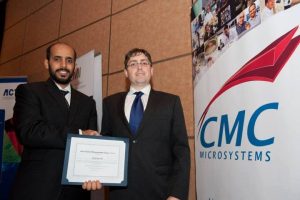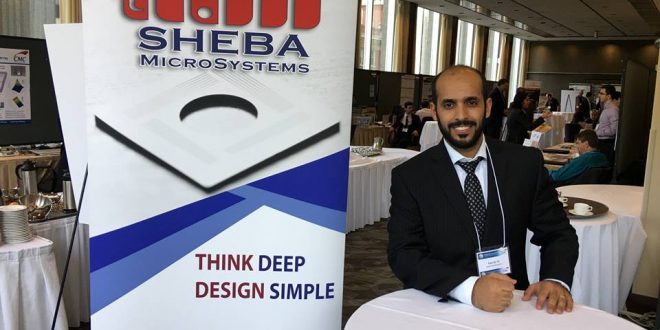*Omar AL-Hayani
Yemeni researcher at the University of Toronto, Canada, Faez Ba-Tis has submitted seven patents applications in the fields of micro-electrostatic actuators, high speed auto-focus and image stabilization miniature cameras, highly sensitive MEMS accelerometers, micro force sensors as well as three-dimensional touch pads or so-called “3DTouch” screen. These inventions have been submitted during Dr. Ba-Tis studies at the department of Mechanical and Industrial Engineering at the University of Toronto .
One of these inventions is about an altra-fast autofocus miniature camera driven by MEMS electrostatic actuator to achieve autofocus and optical image stabilization to cancel hand shake effects during filming. The autofocus mechanism requires a translation of 60 milligram lens barrel (containing five lenses) a stroke of tens of microns within a a fraction of a second -about 10 millisecond. (A micron is equivalent to a part of one thousand parts of one millimeter) .
Ba-Tis explains in an exclusive interview with Al-Jazeera net that the electrostatics actuator he developed with his PhD supervisor, Prof. Ridha Ben Mrad, is the world’s most powerful electrostatic actuator that is able to displace large masses for tens of microns. The current available electrostatic actuators reported are limited to displace only a mass of up to 2 milligrams, whereas the mass required to achieve autofocus and optical image stabilization is in the order of 60 milligrams. Ba-Tis’s electrostatic actuator is able to handle such large mass.
He adds that “the electrostatic actuators is the future technology that is going replace the Voice Coil Motors VCMs (electromagnetic actuators) that are currently the most dominant actuation technology being used in the current smartphone cameras. That is because electrostatic actuators have a number of advantages over the electromagnetic actuators. These advantages include small size, fast response and low power consumption. However, the limitations of these electrostatic actuator is that they are limited to manipulate small masses. With the new advancement achieved by Dr. Ba-Tis, such limitation is being eliminated.

He continues to explain that the electrostatic actuation was an area of interest of many major smartphone vendors to utilize them in smartphone camera, but the limited output force generated from these actuators and limited movement were the main obstacles to use them as an alternative for the VCMs.
There have been already two attempts to utilize the electrostatic actuators to achieve autofocus in smartphone cameras, but they were not successful. Digital Optics and Apple Inc. have previously developed two electrostatic actuators, but they were limited to move only two milligrams mass while the required mass to be displace to achieve autofocus is 60 milligrams.
The integration of these electrostatic actuators in phone cameras adds many advantages such as the small size, high performance speed in the low power consumption that saves the battery life.
Ba-Tis has co-founded a start-up company (Sheba Microsystems) to be an incubator for these inventions and develop these technologies to make them fully integrated products for the consumer electronics market. Sheba Microsystems started its first marketing activities last month when it participated in the Mobile Word Congress 2017 in Barcelona. Sheba released its first MEMS driven miniature cameras at MWC on Feb. 27, 2017.
These inventions are unique achievements for a Yemeni researcher in Canada in the field of MEMS actuators and sensors.
Ba-Tis during receiving his Huawei Microsystems Design Award at CMC conference 2014(the al-jazeera) .
The researcher Ba-Tis achieved his innovations while studying his PhD, which was under the supervision of Prof. Ridha Ben Mrad in Mechatronics and Microsystems Design Lab at the University of Toronto, Canada.
He submitted his seven patents to the United States Patent and Trademark Office, two of which were already granted while other patent applications are still under examination.

Ba-Tis has won a number of awards in innovation competitions during his Bachelor degree, these including the runner up position in Stanford Universities Global Innovation Tournament, Malaysian Challenge in 2009, and the third place in the World Engineering Students Invention Challen., 2011.
During His master’s study, he was announced as the recipient of Huawei Microsystems Design Award at CMC Annual Symposium in Canada 2014.
______________
* Yemeni journalist specializing in scientific affairs
Source: Al –Jazeera
 الشبكة اليمنية للعلوم والبيئة (يمن ساينس) موقع يهتم بأخبار العلوم والتكنولوجيا والصحة والبيئة والسكان
الشبكة اليمنية للعلوم والبيئة (يمن ساينس) موقع يهتم بأخبار العلوم والتكنولوجيا والصحة والبيئة والسكان





